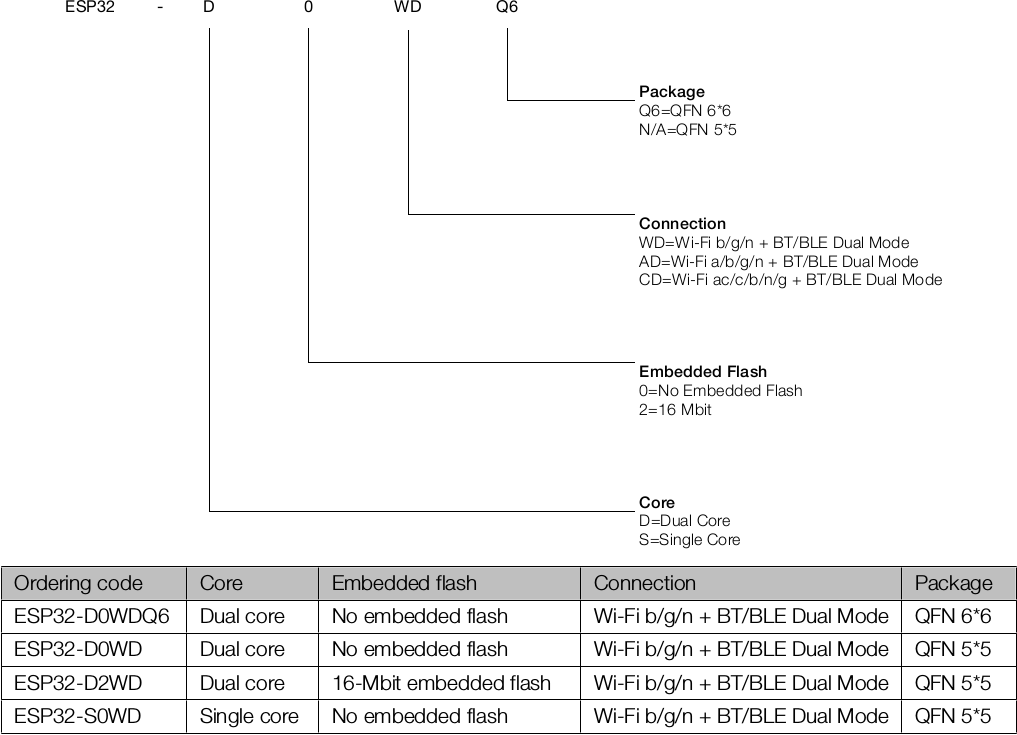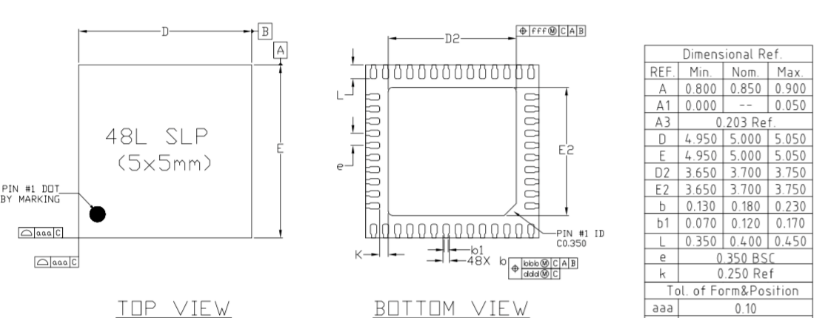Espressif ESP32 was launched last year as a dual core Tensila processor with WiFi and Bluetooth connectivity, relying on external flash for storage, and packaged into a QFN48 6x6mm package. Espressif recently updated ESP32 datasheet, and the guys at ESP32net noticed three new versions of the processor with a QFN48 5x5mm package, one version including 2 MBytes embedded flash, and another version with a single core.
The three new versions of ESP32 all come with the same WiFi 802.11b/g/n ad Bluetooth 4.0 LE connectivity and a QFN 5×5:
- ESP32-D0WD dual core processor without embedded flash
- ESP32-D2WD dual core processor with 16 Mbit embedded flash
- ESP32-S0WD single core processor without embedded flash
ESP32-D0WD different with ESP32-D0WDQ6 is only the smaller package, while ESP32-D2WD brings 2MB embedded flash too possibly lowering the price of current solution with external flash, and ESP32-S0WD might be closer to ESP8266 price thanks to its single core, while still offering Bluetooth Smart support on top of WiFi.
Other interesting – but so far unused – parts of the nomenclature are that future ESP32 version may support 802.11a (AFAIK no that commonly used), as well as 802.11ac for higher WiFi throughput, which would also mean a dual band (2.4 / 5GHz) ESP32 processor (ESP32-D0CD or ESP32-D2CD) might be manufactured in the future.
Thanks to Nanik for the tip.

Jean-Luc started CNX Software in 2010 as a part-time endeavor, before quitting his job as a software engineering manager, and starting to write daily news, and reviews full time later in 2011.
Support CNX Software! Donate via cryptocurrencies, become a Patron on Patreon, or purchase goods on Amazon or Aliexpress







Nice! 16 Mbit = 2 MB so not much storage but still twice as much as largest ESP8266.
Hope that they also come out with an even cheaper 1MB or 2MB single-core ESP32.
802.11ac is most interesting for IoT as handshake time is much quicker.
Handshake time for ESP8266 is around 2-3 seconds, in my experience, so not horrible. If you are spending most of your time in deep sleep, you can probably afford a couple of seconds.
Which is not to say that things can’t be better, of course.
@Rogan Dawes When turing on or off lights then 2-3 seconds can feel like an eternity.
I guess this comes from that we have all learned from prior experience that when you flick a lightswitch the light should go off or come on instantly.
At least using properly implemented Z-Wave and ZigBee for light control does work this instantly.
So what 802.11ac would do is optimize that time to make IoT light control over WiFi feel instant too.
It will usually be les than a second if you give the ESP8266 a static IP to connect with. In a lightswitch you can probably afford to hard-code the wifi and IP.
If it’s hard wired to the AC just keep it always connected.
@Harley
Good point, it seems adequate for non human interactions, otherwise it’s latency hell.
@Harley
I can envision an IoT system more like the “traditional” (as in the Internet applied to industrial process machines and other SCADA tasks…) one wherein you need decent WiFi rate (I’d envision the AC versions of these being less concerned with power consumption (Not all IoT is things like Fitbits…) and having that AC data rate coupled with something to provide as much as one spatial stream in a part with the temperature ranges involved…)
It’s got some possibilities.
It seems few are aware that the 8266 supports light sleep mode which is essentially always connected but using 0.9mA or less. If any packets come in from the router it instantly wakes, so as far as the user can see it’s always on. It even saves energy over deep sleep when doing frequent wake ups, since the power required to wake, send a few packets, and sleep again in a few dozen microseconds beats the pants off even a static IP handshake of hundreds of milliseconds. Also the 2MB unit is an improvement over every 8266 as they all… Read more »
Datasheet for the single core version of ESP32 (ESP32-S0WD): http://espressif.com/sites/default/files/documentation/esp32-s0wd_datasheet_en.pdf